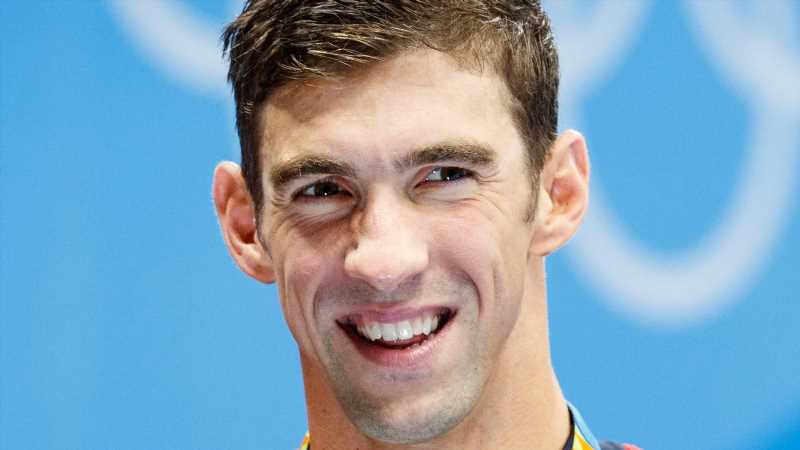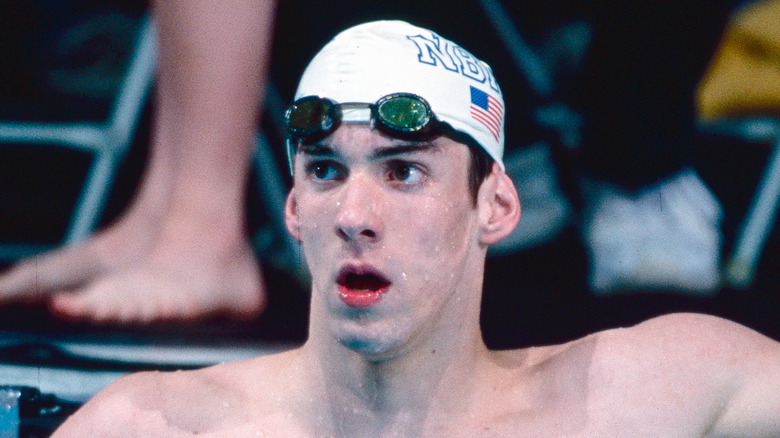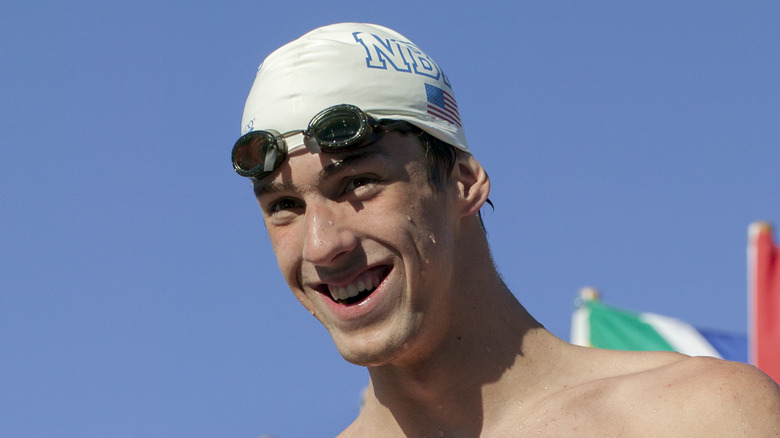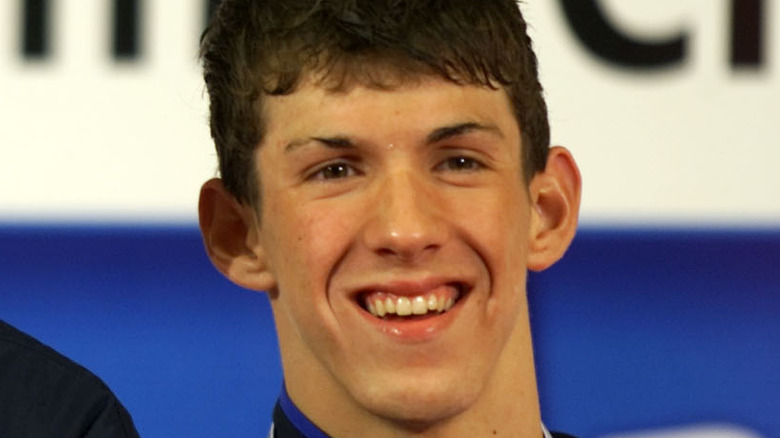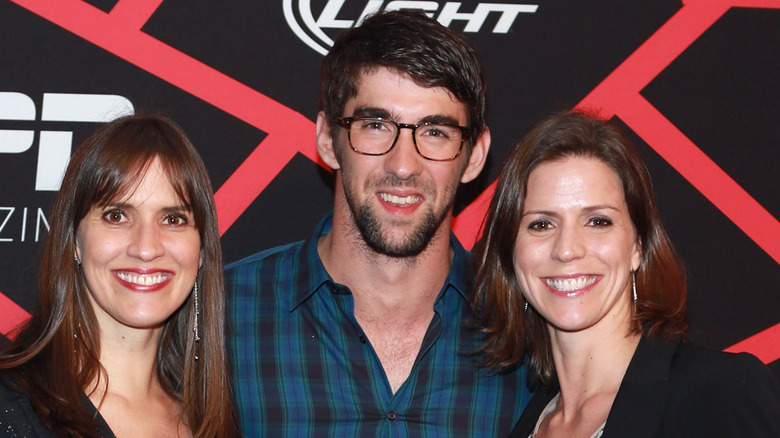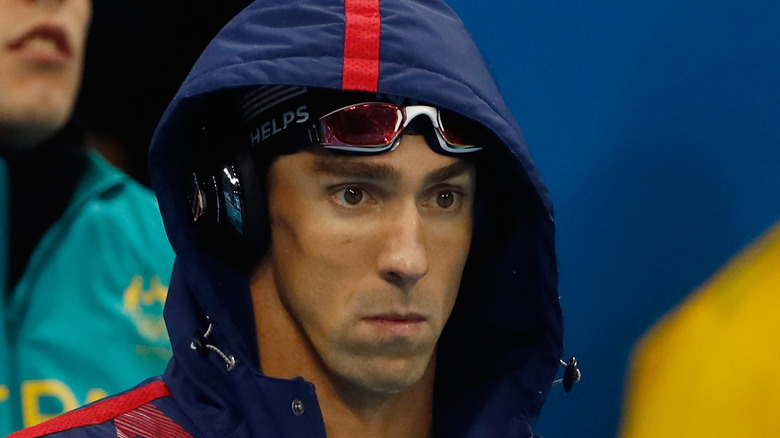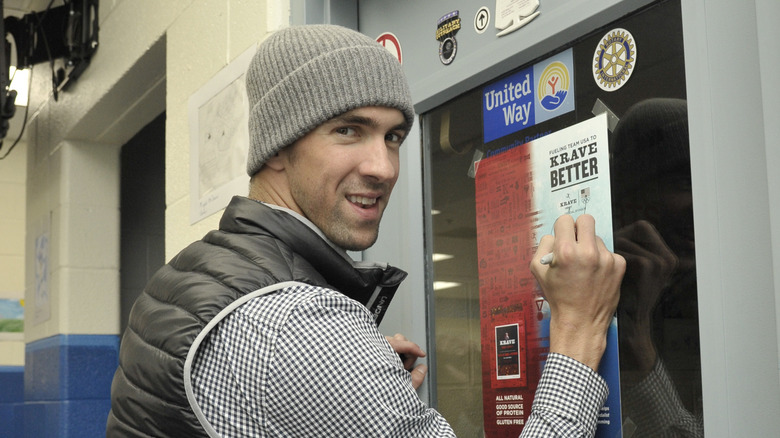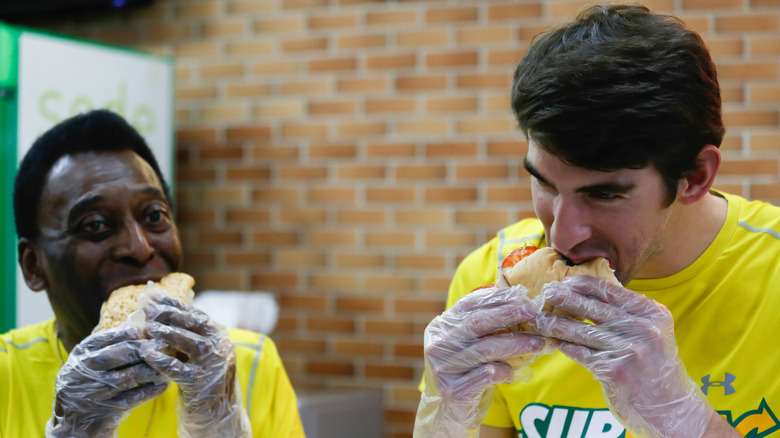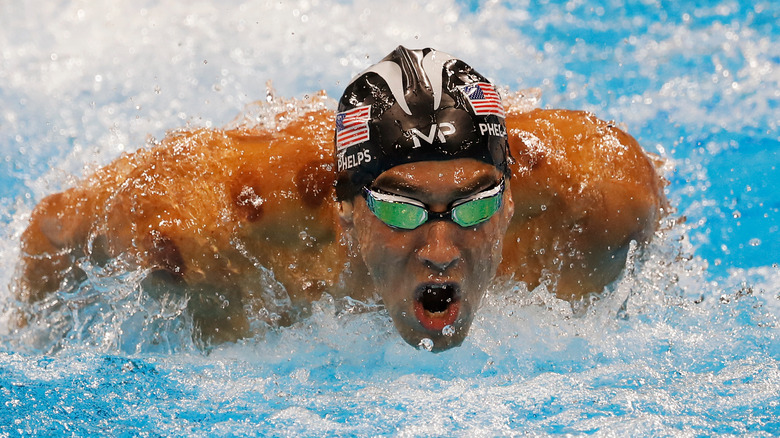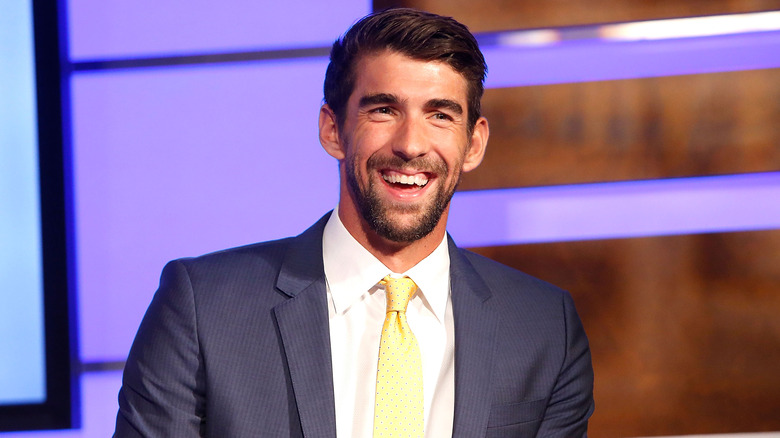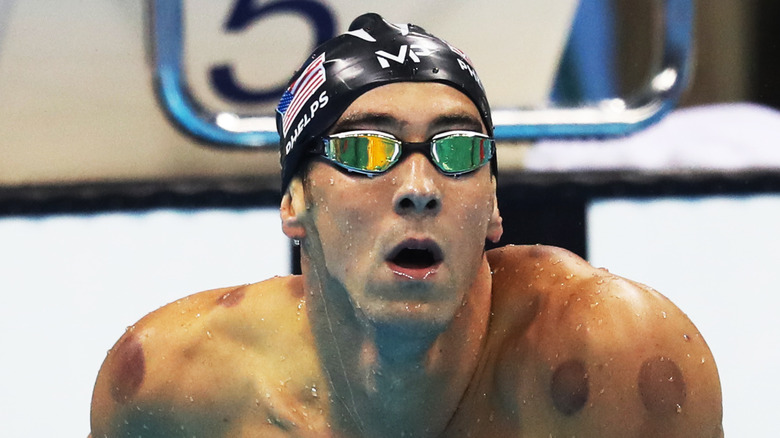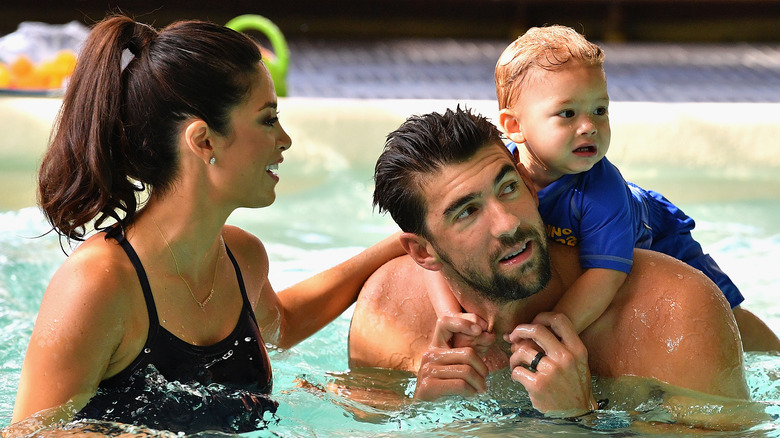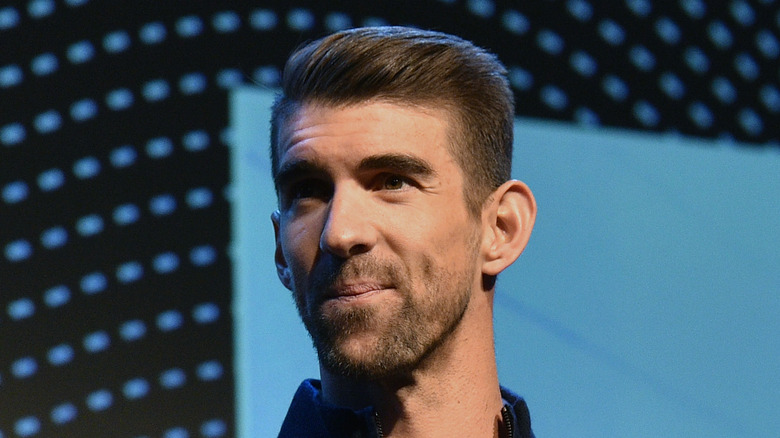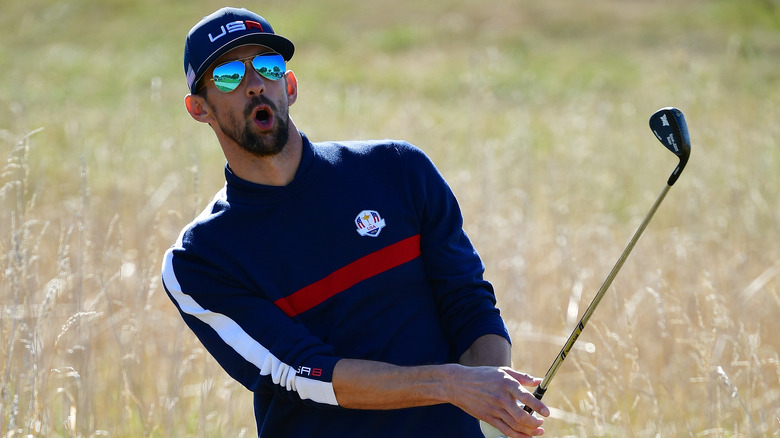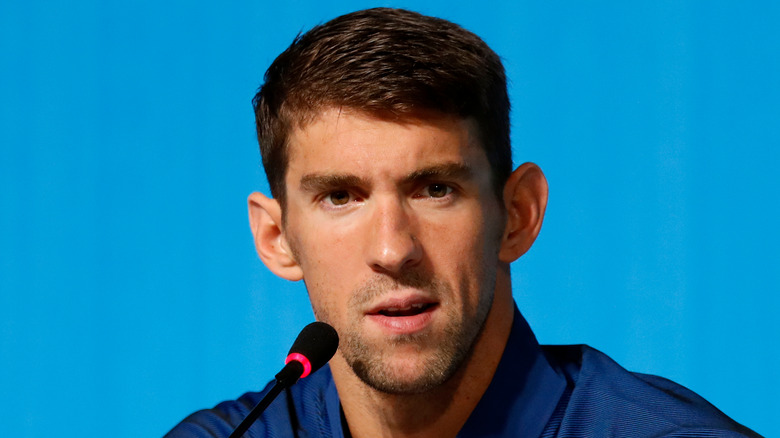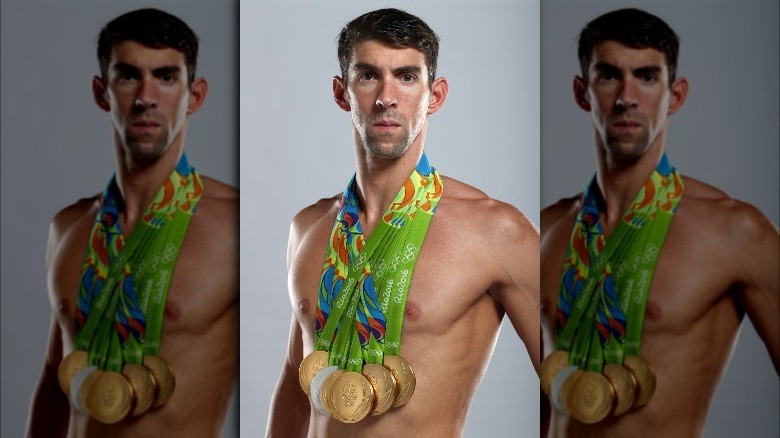The following article includes references to mental health struggles.
In 2000, a 15-year-old Michael Phelps “became the youngest male Olympian since 1932,” per Team USA. Appearing in the final for the 200-meter fly, the swimmer came in fifth, but his disappointing debut would be a rare sight in the years to come. Phelps went on to win medals in the next four Summer Olympic Games. His career total was 28 medals — 23 gold, three silver, and two bronze — and reflective of his incredible performances, Phelps became “the most decorated Olympian of all time.” However, his most impressive year was during the 2008 Beijing Olympics, where Phelps “set seven world records, eight American records and eight Olympic records” to win eight gold medals, one in every event he entered.
During the peak of his swimming career, and prior to his retirement from the Olympics after the 2016 Games in Rio de Janeiro, Phelps’ face was everywhere. For example, he hosted “Saturday Night Live” in 2008, and by 2012, the swimmer had “11 sponsors including, Subway, Hilton, Omega, and all but two of them use Phelps on a global scale,” per Forbes.
Of course, life at the top of your sport isn’t always easy. This celebrated athlete dealt with his fair share of issues long before nabbing his first gold medal, and he was no stranger to controversy during the peak of his Olympic career. But ultimately, the swimmer proved the incredible possibilities of the human body with his performances. Let’s dive into the untold truth of Michael Phelps.
Inside Michael Phelps' childhood
Michael Phelps was born in 1985 in Baltimore, Maryland, per Biography. He grew up in the Rodgers Forge neighborhood with his two parents, Fred and Deborah Phelps. While his dad was once an athlete himself — as “a former college football player who tried out for the Washington Redskins,” according to the Baltimore Sun — Michael’s mom, whom he calls “Debs,” worked as an “administrator at Loch Raven Academy.”
However, the future Olympian’s parents separated early in his life, and ultimately divorced. After the split, Michael and his older sisters lived with their mother. But even after his first Olympic appearance, Deborah still showed that she was the one in charge of the teenager: As Michael remembered, “Debs made me come home early from the Olympics,” which made the young swimmer miss his chance to get the “free Razor scooter the athletes received.”
Michael’s mom often gets much of the credit for raising the Olympic swimmer, and while his dad also credits his ex-wife with doing a great job in raising Michael, Fred does feel left out of the story. “Just because he lives with Debbie doesn’t mean I didn’t have anything to do with this,” Fred confessed to the Baltimore Sun in 2001. “It’s like I didn’t exist.” That said, Fred made sure to keep the focus on the Olympian, saying about his famous son, “He’s the one in the pool. It’s his story. It’s not Debbie’s story. It’s not my story.”
The story behind the Olympian's first time swimming
Michael Phelps’ journey to Olympic glory started back in 1992. Seven years old at the time, he started to swim “mainly because his older sisters, Whitney and Hilary, were swimming,” according to Team USA. Even though his siblings were already comfortable in the pool, Michael’s mom, Deborah, remembered a hesitant young boy. “At age seven, he hated getting his face wet,” she revealed to Additude Mag. But Debs had a simple solution, recalling, “We flipped him over and taught him the backstroke.”
By 1995, Michael had quickly improved his swimming skills. At this time, the 10-year-old “held a national record for his age group and began training with Bob Bowman,” per Team USA. Under the tutelage of his coach, Michael’s abilities only got better. He soon began setting records left and right in the pool. In fact, many of Michael Phelps’ records set in the different age groups and events have remained the ones to beat over 20 years later, per USA Swimming.
What was life like for a teenage Michael Phelps?
As Michael Phelps got better at swimming, those around him began to notice the young man as somewhat of a semi-celebrity. (Hey, it’s not often that a teenager from small-town Maryland competes in the Olympics.) And yet, at this point in this life, Phelps was also a lanky kid dealing with the usual struggles that come with being a student.
As the Baltimore Sun noted, he was once “a boy who wanted to get his braces off before the Olympics.” Phelps was also reportedly a “a shy kid at Dumbarton Middle School who had trouble sitting still in class.” One of his friends around that time, an eighth-grader named Molly Baldwin, started to spend time with Phelps, who was in sixth grade. Claiming that the two dated and that “he was so much fun,” Baldwin explained that she and Phelps ended their relationship when she went off to high school.
By the time Phelps had graduated middle school, the soon-to-be Olympian’s celebrity had increased and his personality had apparently somewhat changed. In Baldwin’s opinion, the aspiring Olympic athlete “stayed true to his character,” but also was “not as shy as he used to be.” And for his fellow high schoolers, apparently simply seeing the swimmer in the halls was a big deal. Baldwin remembered “girls were swarming all around him,” before recalling hearing one fellow student exclaim, “Oh my God! I touched him!”
The Phelps family is full of talented swimmers
As previously mentioned, thanks to his older sisters, Michael Phelps started to swim. But his siblings were more than just casual swimmers in the pool. Hilary, the oldest of the Phelps kids, went to the University of Richmond. In a 2001 interview with the Baltimore Sun, she revealed that she still held three swimming records from her career at the university. Middle child Whitney was also an incredible swimmer: When she was only 14 years old, she “was ranked third in the world in the 200-meter butterfly,” per the outlet. It’s worth noting that this was even better than her younger brother, Michael, who was ranked seventh in the world in the same event by the time he was 15 years old.
Whitney also appeared to be on her way to participating in the Olympics as a teenager. “When she came home and said ‘I’m world-ranked,’ I said, ‘Oh, that’s good,'” her mom, Deborah, remembered. But looking back, she admitted of thinking her daughter would easily go to the Olympics, “I was naive.” When Whitney was 15 and still one of the best Americans in the 200-meter butterfly, she went to the 1996 Olympic trials. Unfortunately, she came in sixth place at the event and failed to make the team. Whitney’s coach at the time claimed the result was partly from a back injury and partly from nerves of the big moment.
“It left a scar,” Michael said of Whitney’s performance, recalling, “That devastated us. We were in ruins.”
Michael Phelps reveals what music pumps him up
Ever since he was a teenager, Michael Phelps has used music as a way to bring out his best swimming performances. As of at least 2001, the swimmer has loved to listen to rap. According to the Baltimore Sun, two of his favorites to listen to “just moments before he compete[d]” were the late DMX and Eminem. Even in Phelps’ last Olympic Games turnout, spectators could see the swimmer sporting headphones prior to an event. However, his most memorable and viral moment came when cameras captured Phelps giving a “death stare” just before the 200-meter butterfly semifinal at the 2016 Summer Olympics in Rio de Janeiro (via a CBS News video). With his hood up and over-the-ear headphones in, Phelps glared as his competitor, Chad Le Clos from South Africa, shadowboxed.
While presenting at the MTV Video Music Awards later that year, Phelps finally revealed what he was listening to during the viral moment. The Olympian announced to the audience, “Remember in Rio when I made that face that ended up all over the internet? I was in my zone with Future’s track, ‘Stick Talk,’ blaring in my headphones.”
This Olympic swimmer has a charitable side
Following his incredible performance of winning eight gold medals at the 2008 Beijing Olympics, Michael Phelps used his resources to help others. “My goals reach beyond the pool, to helping others realize their dreams and continuing to grow the sport I love so much,” the swimmer said in a statement, per ESPN. Speedo, one of Phelps’ main sponsors, paid the athlete a $1 million bonus for his record-setting performance in Beijing. Phelps went on to explain, “I feel it’s only appropriate that I continue the momentum that Speedo helped to create, by committing my bonus to the establishment of the Michael Phelps Foundation, which I hope will help me inspire others to achieve their dreams and give back to the sport that has given me so much.”
Phelps later went on a tour around the U.S. with his foundation “to visit children and share his Olympic experiences.” With Speedo helping to sponsor the tour — even donating an additional $200,000 to the foundation — the initial campaign focused on giving kids direction to include exercise as part of a healthy lifestyle. Since then, many of the closest people in Phelps’ life have become involved in his foundation: Board members include his mom, Deborah Phelps, and his former coach, Bob Bowman.
According to the foundation’s website, more than 100,000 people have benefited from its learn-to-swim curriculum, as of 2021.
At one point, nobody had a bigger appetite than Michael Phelps
As a young boy, Michael Phelps had a gigantic appetite, like many teenagers do. For example, a local restaurant that Phelps frequented as a teen called Pete’s Grille detailed his big go-to meal. According to the Baltimore Sun, following a five-mile swim practice, Phelps would eat “stacks of chocolate chip pancakes, bacon-and-egg sandwiches, multiple omelets and heaping bowls of grits. All at one sitting.” The restaurant’s co-owner, Darlene Castle, explained that she once thought of adding his signature order to the menu in order to celebrate the Olympian’s hometown roots, but admitted, “It would be so much food that I don’t think anybody could eat it.”
At his peak abilities as an Olympic swimmer, Phelps continued to consume an admittedly insane amount of food. While at the 2008 Summer Olympics — and during the best performance of career — Phelps explained his diet to NBC Sports, “I don’t cook — at all. I was told that I was supposed to eat between eight and 10,000 calories a day. I just sort of try to cram whatever I can into my body.” And Phelps didn’t hold back on his choices, adding, “It’s pretty much whatever I feel like eating, I’m going to eat.”
During his appearance on “Saturday Night Live,” Phelps took part in a skit making fun of his high caloric intake, which featured the Olympian promoting a fake “Michael Phelps Diet,” in which followers could eat huge quantities of food.
That time Michael Phelps raced a shark
During the Discovery Channel’s yearly “Shark Week” event in 2017, Michael Phelps promoted a race between himself and a great white shark. This animal can reportedly swim up to 10 times faster than humans, leaving the Olympian slim chances to win. “Being able to become almost face-to-face with some of the largest predators and animals that we could find is something that was exciting and just an opportunity that I couldn’t pass up. It’s been a bucket list item for me for years,” Phelps told Entertainment Weekly.
Equipped with a monofin to give himself extra propulsion, Phelps explained that he swam solo, racing in open water near South Africa with “about 15 safety divers around.” However, many fans were disappointed by the end result of the race. “When the ‘race’ was shown, Phelps was matched with a computer-generated image of a shark, supposedly simulating a real shark’s speed,” The New York Times recapped, noting, “The ‘shark’ even leapt out of the water at the finish line for a conveniently spectacular visual.”
After the lackluster event, a spokeswoman for the channel, Laurie Goldberg, explained that the special was “to get people excited about sharks.” She then clarified that there was no intention to put Phelps’ life at risk against a shark, adding that “in the first two minutes of the show, we make it clear we were not going to make it side by side.”
This Olympian's body is like no other
After seeing Michael Phelps’ complete domination in the water, it’s understandable that some might think the swimmer is a freak of nature (y’know, in a good, Olympic medal-winning way). In fact, his body is built differently, which means that the Olympian has several physical quirks that have helped him become one of the best athletes ever. For example, Phelps “is double-jointed in the elbows, knees, and ankles — just one of his many advantages in the pool,” a video by the Olympics described. As for his double-jointed ankles, The Washington Post explained that this gave Phelps’ swimming “kick unusual range.” Meanwhile, the swimmer’s “double-jointed elbows allow Phelps to create more downward thrust in the water,” per Biography.
The Olympian’s “large hands also act like paddles,” as the latter outlet described. And even though Phelps is quite tall — 6 feet, 4 inches — his proportions are atypical. His torso is especially long for this height, and Phelps has “the legs of a man 8 inches shorter” — which have helped him produce less drag as he swims.
In addition to his body shape, Phelps’ internal science also stood out among his competition. A study showed that the Olympian produced “half the lactic acid of his competitors,” per The Telegraph. This acid naturally occurs after physical exertion and during recovery, as the body flushes out the lactic acid. This means that, for Phelps, he could recover “in just a few minutes, which is how he has managed to win gold after gold in quick succession in the past.”
The truth behind those weird marks on Michael Phelps
During the 2016 Olympics, the world watched as Michael Phelps returned to the Summer Games in hopes of even more medals for swimming. But aside from questioning how many golds he could bring home, many fans wondered about Phelps’ physical appearance. Specifically, why he had a bunch of purple circles on his back during his Olympic events (as a swimmer, he couldn’t hide from showing off a lot of skin in a swimsuit). It turns out that the marks were actually from “an ancient Chinese healing practice” called cupping, The New York Times reported.
Keenan Robinson, Phelps’ personal trainer at the time, downplayed the practice and called cupping “just another recovery modality,” saying, “There’s nothing really particularly special about it.” Meanwhile, as Phelps explained about the method, “I’ve done it before meets, pretty much every meet I go to.” According to the swimmer, if he felt sore, it would help to go through a cupping session. However, he also remembered the times when “the trainer hit [him] pretty hard and left a couple of bruises.”
Robinson echoed the sentiment that, while good for recovery, cupping left Phelps with marks on his skin that looked “like a Dalmatian or a really bad tattoo sleeve.” On an Instagram post shared in 2015, Phelps showed the practice of cupping in action with a snapshot in which a trainer smiled while placing a cup — one of many — on the back of the Olympian’s legs.
This former Olympian became a family man
While attending the 2007 ESPY awards, ESPN’s annual red-carpet celebration of athletes, Michael Phelps had an unexpected encounter. One of the network’s employees, Nicole Johnson, was assigned to be his escort at the event — and a decade later, Phelps opened up about their meet-cute to ET.
“It’s funny, she always tells the story like, ‘I wanted somebody different,’ and I was like, ‘Oh thanks honey, really, really like that,'” the Olympian joked. He explained that the two started dating and had been “on and off for 10 years,” eventually marrying and welcoming their first son, Boomer, together in 2016. Looking back at their marital success following their first meeting, Phelps claimed his wife said, “Everything works out for a reason.”
Nicole and Michael have since expanded their family even more. As of 2021, both were proud parents of three boys, the New York Post reported, having welcomed Beckett in 2018 and Maverick the following year. Nicole’s Instagram account often shows her with her big family, which also includes their two dogs, Juno and Legend. In addition to being a super mom, Nicole is also a philanthropist, serving on the advisory council for the Michael Phelps Foundation.
Some controversial moments have surrounded Michael Phelps
In 2004, Michael Phelps’ dreams came true. At the Summer Olympics held in Athens, Greece, the swimmer won his first gold medal in the 400-meter individual medley, and left the Games with a total of eight medals. But later that year, poor judgment led to Phelps making headlines for all the wrong reasons.
A state trooper pulled a 19-year-old Phelps over in Maryland after running a stop sign, CBS News reported, and soon suspected he was inebriated. After being “charged with driving under the influence, driving while impaired, violation of a license restriction and failure to obey a stop sign,” per the outlet, he was given 18 months of probation. Five years later, a photo of Phelps circulated the internet, in which he appeared to be “inhaling from the type of glass pipe used to smoke cannabis,” The Guardian reported. In addition to being “suspended from competition for three months by his swimming authority,” the scandal led to one of his sponsors, Kellogg, dropping him. However, things came to a head in 2014, when Phelps was charged with another DUI after being pulled over for speeding. USA Swimming suspended him for six months, and Phelps checked himself into a 45-day rehab program.
“I was in a really dark place,” Phelps explained to SI. “Not wanting to be alive anymore.” While the Olympian told the “Today” show that he hadn’t been struggling with alcohol addiction but rather “binged,” he explained in 2016, “I checked myself in, because I think I was at a point in my life where something needed to change.”
If you or someone you know is struggling with mental health, please contact the Crisis Text Line by texting HOME to 741741, call the National Alliance on Mental Illness helpline at 1-800-950-NAMI (6264), or visit the National Institute of Mental Health website.
Another huge athletic achievement for Michael Phelps
In 2012, Michael Phelps set several records in the world of sports. At the Summer Olympics held in London, the swimmer earned his 19th medal, officially making him the most decorated Olympic athlete ever, The Wall Street Journal reported. But outside the Olympics, Phelps set a record in a sport he didn’t even play professionally — golf.
That year, at the Dunhill Links Championship at Kingsbarns in Scotland, Phelps paired up with pro golfer Paul Casey. The swimmer lined up a putt that, according to Casey’s caddy, “was from 159 ft., or 53 yards” — longer than half the length of a football field. A video of the putt showed the ball moving for 17 seconds. This was enough time for the commentators to talk about Phelps’ gold medals and, as it rolled closer, ask, “Where is this putt going?” Right before the ball sank in the cup, the commenter said, “He couldn’t. He has!” Phelps pumped his arms in joy, and the announcer claimed the stroke was “as long a putt as I think we’ve ever seen.”
According to the Daily Mail, the over-fifty-yard putt became the longest one ever televised. “It was the longest putt I’ve ever had and to see it go in was a pretty cool feeling,” Phelps said of his amazing shot. Meanwhile, golf analyst Ewen Murray described the stroke as “perfect,” with the ball “traveling down three different levels at the perfect pace.”
Michael Phelps reveals his internal struggles
It’s easy to celebrate Olympians after they win medals for their home countries, but few recognize the immense pressure and long hours that went into those moments. In an HBO documentary called “The Weight of Gold,” Michael Phelps — who served as an executive producer and also provided his voice as the film’s narrator — talked about his mental health struggle with anxiety and depression as an Olympic athlete. Several other famous Olympians, ranging from snowboarder Shaun White to figure skater Sasha Cohen, also appeared in the documentary, and all shared similar stories.
“We were all saying, ‘Nobody helps us’ and ‘We’re just products,'” Phelps told USA Today. “… Because I thought every sport is so different, every individual would be so different, yet there’s 15 to 20 of us in the film that go completely against that statement.”
Even before he competed in the Olympics, Phelps also dealt with ADHD. In a 2017 video for Child Mind Institute, the swimmer talked about living with the disorder. “That’s something I’ve lived with my whole entire life and will continue to live with,” the Olympian said, adding, “It’s been something that’s changed my life since the beginning.” Phelps, who has long been open about his positive experience with therapy, went on to say, “I think the biggest thing for me, once I found that it was okay to talk to somebody and seek help, I think that’s something that has changed my life forever, and now I’m able to live life to the fullest.”
If you or someone you know is struggling with mental health, please contact the Crisis Text Line by texting HOME to 741741, call the National Alliance on Mental Illness helpline at 1-800-950-NAMI (6264), or visit the National Institute of Mental Health website.
How much is Michael Phelps worth?
Michael Phelps is a rarity in his sport for many reasons. Besides his obvious domination in swimming competition, he’s also highly profitable in a sport that generally goes unnoticed in between the Olympic Games. As a result of the swimmer’s unprecedented medal run in 2008, Phelps set himself up for huge payouts. According to Forbes, his agent, Peter Carlisle, predicted the Olympian “could earn $100 million over the course of his lifetime from sponsors.” And over a decade later, Phelps was already getting closer to that prediction.
According to Celebrity Net Worth, Phelps’ fortune was worth an estimated $80 million in 2021, with the swimmer reportedly “enjoy[ing] one of the most lucrative post-Olympics careers in American history,” in part due to his sponsorships from the likes of Speedo, Under Armour, Visa, Wheaties, and more. With that kind of money, the Maryland native could likely live anywhere he wanted — and Phelps has used some of his earnings to splurge on a 6,010-square-foot, $2.5 million home in Scottsdale, Arizona. According to Town & Country, the luxurious, five-bedroom residence rests “on almost an acre of land near Arizona State University,” and boasts a pool and four total fireplaces.
As for Phelps’ money-making power, this retired Olympian is showing no signs of slowing down. Back in 2016, he told CNBC of his entrepreneurial aspirations, “You never know what can happen. I love to get involved in small things on the side and have fun with stuff. I guess only time will tell.”
Source: Read Full Article
